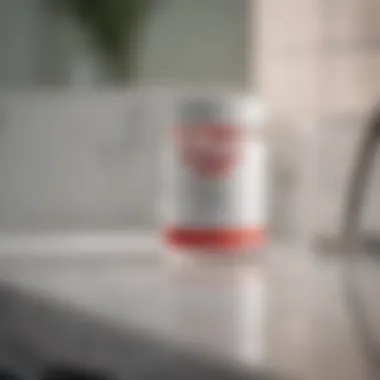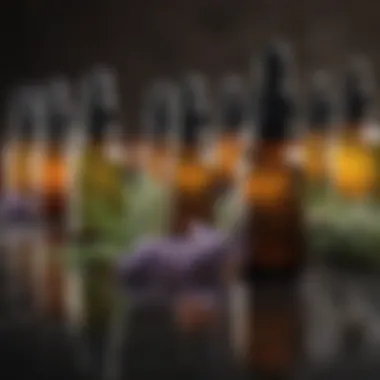Top Products to Effectively Dry Out Pimples


Intro
Acne affects individuals across age groups and skin types. Pimples, in particular, can be distressing and difficult to manage. The desire to find effective products for drying out these blemishes leads many to explore various solutions. This article examines both over-the-counter options and natural remedies that target acne. Understanding the ingredients and mechanisms behind these products is essential for effective treatment. Additionally, integrating these products into your skincare routine involves careful consideration of individual skin types.
With the right knowledge, selecting the most suitable products can become a more straightforward process. This guide aims to equip readers with insightful information on how to manage pimples effectively.
Tips and How-Tos
Finding the right product to address pimples requires knowledge of one's skin type and specific needs. Here are some tips and how-tos to help navigate this process:
Skincare Routines for Different Skin Types
- Oily Skin: Look for lightweight, oil-free products. Ingredients like benzoyl peroxide and salicylic acid can be beneficial. Consider using gel-based treatments for direct application to pimples.
- Dry Skin: Choose products that avoid excessive drying. Slightly more hydrating ingredients, such as tea tree oil, can help balance moisture while still targeting blemishes. Consider hydrating gels or creams instead of traditional drying treatments.
- Combination Skin: Identify areas needing special care. Use salicylic acid for oil-prone sections while applying gentler products on dry patches.
- Sensitive Skin: Reducing irritation is paramount. Opt for products with calming ingredients, such as chamomile or aloe, while steering clear of strong chemicals that may cause redness.
Practical Product Application Tips
- Always clean your skin before applying any treatment. This ensures that the ingredients penetrate effectively.
- Utilize a spot treatment for targeted action on individual pimples.
- Avoid mixing multiple potent products, as this can lead to irritation.
- Test new products on a small skin area before wider application to avoid adverse reactions.
General Considerations for Effective Treatment
- Frequency of Use: Use spot treatments once or twice a day as needed.
- Avoid Over-Treatment: Using too much product can lead to skin irritation.
- Patience is Key: Most treatments take time to show results; consistency is essential.
"Many times, individuals have unrealistic expectations about the speed of acne treatment results. Understanding the timeline helps in managing frustrations."
Exploring these tailored approaches helps ensure a more effective and personalized pimple management strategy.
Sustainable Practices
Sustainability in skincare is increasing in importance. Many consumers seek eco-friendly options that align with their environmental values.
Eco-Friendly Product Choices
- Opt for brands that use natural ingredients, minimizing harmful preservatives.
- Support companies with sustainable packaging practices.
- Consider products that are cruelty-free and vegan.
Selecting Sustainable Grooming Products
Find options that not only benefit your skin but also respect the planet. Look for brands that prioritize ethical sourcing and eco-friendly production options.
Wrap-up
Understanding Acne Formation
Acne is not just a beauty concern; it impacts self-esteem and overall well-being. Understanding acne formation is crucial for selecting effective treatments, especially for drying out pimples. This section covers the main elements that contribute to the development of acne and how knowledge of these factors aids in managing breakouts.
Causes of Pimples
Pimples, often referred to as zits or spots, stem from multiple factors. One of the primary causes is hormonal fluctuations. For instance, during puberty or menstrual cycles, hormone levels surge, leading to increased oil production in the skin. Stress can also trigger hormonal changes, causing acne flare-ups.
Moreover, certain medications can influence acne formation. Steroids and some contraceptives are common culprits. Diet may also play a role. High-glycemic foods, for example, can exacerbate acne symptoms for some individuals.
The Role of Excess Oil
Excess oil, also known as sebum, is a leading cause of acne. Sebum is necessary for skin health; however, when produced in excess, it can clog pores. Clogged pores trap dead skin cells and bacteria, leading to inflamed pimples. Individuals with oily skin are particularly prone to this issue.
It's worth noting that certain skincare products may exacerbate oiliness. Non-comedogenic products are advisable, as they do not clog pores. Choosing the right skincare routine becomes essential in managing excess oil and preventing breakouts.
Bacterial Influence


The skin is home to various bacteria, some of which are harmful when they multiply excessively. Propionibacterium acnes is one such bacterium linked to acne development. Increased oil and dead skin create an environment where this bacterium thrives, leading to inflammation and acne lesions.
Utilizing products that contain antibacterial agents can effectively combat this bacterial influence. Products with benzoyl peroxide are well-known for this purpose. Understanding the role of bacteria helps in selecting treatments and preventing future breakouts.
"Knowledge of acne formation empowers individuals to make informed decisions about managing and preventing breakouts."
In summary, understanding the complexity of acne formation, including the causes, oil production, and bacterial presence, is foundational for anyone looking to treat and prevent pimples effectively. This knowledge allows for the selection of targeted products, ensuring a focused approach to skincare.
Importance of Drying Out Pimples
Understanding the significance of drying out pimples is crucial for effective acne management. It is not merely about treating the visible symptoms but addressing the underlying issues contributing to acne formation. By focusing on the drying process, one can effectively mitigate inflammation and combat various skin imperfections.
Reduction of Inflammation
Drying out pimples plays a vital role in the reduction of inflammation. When a pimple forms, it often results from bacteria, excess oil, and dead skin cells clogging pores. This setting invites inflammation as the body's immune response kicks in. Products that help dehydrate the area can effectively minimize swelling and redness, making the pimple less noticeable.
During this reduction process, active ingredients such as benzoyl peroxide and salicylic acid come into play. They can penetrate deep into the skin, breaking down excess oil and facilitating the shedding of dead skin. As inflammation decreases, so does the pain associated with acne lesions. This is why targeted treatments with drying properties can lead to faster relief and clearer skin.
Fact: Reducing inflammation not only enhances appearance but also promotes faster healing of affected areas, reducing the time pimple is present on the skin.
Prevention of Scarring
Another important aspect of drying out pimples is its role in preventing long-term skin damage, such as scarring. When acne lesions heal but the skin remains inflamed, the likelihood of scarring increases significantly. By using effective drying methods early in the pimple's lifecycle, you can help limit the degree of tissue damage.
Preventing scars is particularly significant for women of all ages, as scarring can lead to further emotional distress and a prolonged recovery process. If a pimple dries up quickly, the skin has a higher chance to recover without permanent marks. Products formulated with sulfur or tea tree oil can offer not only drying capabilities but also offer anti-inflammatory benefits, further supporting healthy healing.
Common Active Ingredients
Understanding the common active ingredients is crucial in selecting suitable products for drying out pimples. Each ingredient plays a distinct role in treating acne and can significantly impact skin health. Knowing these can help individuals tailor their approach to acne management effectively.
Benzoyl Peroxide
Mechanism of Action
Benzoyl peroxide is one prominent compound often used in acne treatment. It works primarily by penetrating the skin and releasing oxygen, which targets and eliminates acne bacteria. This unique characteristic makes it especially effective for treating inflammatory acne. Additionally, benzoyl peroxide helps to unclog pores by exfoliating skin. However, it is essential to apply it judiciously to avoid potential irritation.
Potential Side Effects
While benzoyl peroxide is effective, potential side effects should not be overlooked. One major concern includes skin dryness, especially in individuals with sensitive skin. Redness and peeling are common reactions when overused. Therefore, balancing its use is necessary to gain benefits without experiencing excessive irritation.
Salicylic Acid
Benefits for Oily Skin
Salicylic acid is another active ingredient well-regarded for its benefits, particularly for oily skin types. It exfoliates the skin's surface and penetrates deeply into the pores, helping to dissolve excess sebum and dead skin cells. This property not only helps clear existing acne but also prevents future breakouts by maintaining clear pores. Users often appreciate its gentle approach compared to more aggressive ingredients.
Usage Guidelines
When using salicylic acid, it is vital to follow usage guidelines to achieve optimal results. A concentration of 0.5% to 2% is common in over-the-counter products. Starting with once daily application and gradually increasing as tolerated is recommended. This careful introduction helps mitigate potential irritations while allowing the skin to adapt.
Sulfur
How It Works
Sulfur is an ingredient that has been in use for many years in acne treatment. It reduces excess oil, helping to dry out pimples effectively. Sulfur works by not only absorbing oil, but also by unclogging pores and reducing inflammation. This characteristic positions it as a solid option for those struggling with acne.
Formulations Available


There are various formulations available that include sulfur, ranging from topical creams to masks. Many products are also combined with other active ingredients to enhance their efficacy. Despite its strong smell, many users find it effective and often tolerate it well, making sulfur a practical choice for acne management.
Effective use of common active ingredients is essential for managing pimples successfully. Choosing the right product based on individual skin types can make all the difference.
Over-the-Counter Topical Treatments
Over-the-counter topical treatments play a crucial role in managing acne, especially for those seeking immediate relief from pimples. These products are readily available and often formulated with specific active ingredients aimed at drying out pimples and reducing inflammation. The accessibility of these treatments enhances their appeal. Furthermore, knowing how to effectively use these products can significantly improve their outcomes.
Spot Treatments
Applying Effectively
To achieve the best results from spot treatments, it is essential to apply them correctly. Targeting the exact area where a pimple has formed is important since these treatments are often more potent in small doses. A key characteristic of effective application is using a clean applicator or fingertip to minimize the risk of further irritation or infection. This method allows for concentrated treatment, delivering active ingredients directly to the affected area. However, some users may find that improper application can lead to dryness or peeling of surrounding skin, highlighting the need for moderation and attention.
Key Products to Consider
When selecting spot treatments, focus on those with recognized active ingredients like benzoyl peroxide or salicylic acid. These products often contain high concentrations of acne-fighting components, which can target and dry out pimples effectively. An advantage of these spot treatments is their targeted approach, making them a popular choice for quick treatment. However, it’s important to note that some individuals may experience irritation or allergic reactions, emphasizing the importance of reading product labels and possibly consulting with a dermatologist before use.
Cleansers with Active Ingredients
Cleansers formulated with active ingredients have the dual benefit of cleansing the skin and helping to manage acne. Incorporating these cleansers into a daily skincare regimen can significantly impact acne-prone skin. Their active components work while you cleanse, often offering a convenient method to treat multiple areas of the face.
Daily Use Recommendations
For optimal results, use cleansers with active ingredients daily. This consistency helps to maintain clearer skin and can prevent new pimples from forming. Cleansers like those with salicylic acid or benzoyl peroxide can effectively address existing breakouts while preventing future occurrences. A useful feature of these cleansers is their ability to act as both a wash and a treatment in one, simplifying the skincare routine. While effective, overuse may lead to dryness or irritation, so it is advisable to monitor skin reactions closely.
Effect on Acne Prone Skin
Cleansers with active ingredients have a direct effect on acne-prone skin, helping to exfoliate dead skin cells and reduce oiliness. The right cleanser can balance the skin's oil production while eliminating impurities and bacteria. One valuable aspect is the ability to clear pores effectively, reducing the likelihood of acne formation. Yet, it should be noted that individuals with sensitive skin may find some formulations too harsh, suggesting the need for careful selection based on individual skin types.
"Over-the-counter topical treatments are an essential tool in the fight against acne, offering variety and accessibility for effective skin management."
Understanding how to integrate these products into a daily routine can enhance their effectiveness, making them indispensable for individuals troubled by acne. By considering the unique properties and potential side effects of various treatments, individuals can devise a personalized approach to acne management.
Natural Remedies for Drying Out Pimples
Natural remedies have gained popularity for managing acne due to their gentle nature and reduced risk of irritating skin compared to some chemical treatments. They offer effective ways to dry out pimples while potentially providing additional benefits such as nourishment and anti-inflammatory properties. This section will explore Tea Tree Oil and Aloe Vera—two common natural remedies known for their acne-fighting capabilities.
Tea Tree Oil
Effectiveness and Application
Tea Tree Oil is recognized for its antimicrobial and anti-inflammatory characteristics. It can kill acne-causing bacteria on the skin’s surface. When applied, it penetrates the skin and helps reduce redness and swelling associated with pimples. The oil is also appreciated for being easy to apply. Users typically dilute the oil before application to prevent skin irritation. This process of dilution allows for a more controlled application. Many find it effective as a spot treatment, directly targeting the affected areas.
Cautions and Considerations
While Tea Tree Oil is generally safe, it is crucial to exercise caution. Some individuals may experience allergic reactions to the oil, resulting in increased redness or itching. It is advisable to do a patch test on a small skin area before full application. Additionally, avoid using undiluted Tea Tree Oil, as this can lead to severe irritation. Always seek high-quality, pure oils to ensure effectiveness and safety. The benefits of its antibacterial properties must be weighed against the potential drawbacks of improper use.
Aloe Vera
Anti-inflammatory Properties
Aloe Vera is renowned for its soothing properties. Its gel contains compounds that reduce inflammation and help promote healing. This feature makes it particularly appealing for individuals with inflamed acne. Aloe Vera can hydrate the skin without clogging pores, which is essential for acne-prone skin. Applying Aloe Vera can aid in calming red, inflamed pimples, leading to a more even skin tone.
Application Techniques
Applying Aloe Vera can be straightforward. Users can take a fresh leaf, slice it open, and apply the gel directly to the skin. However, there are also commercially available Aloe Vera gels that can be convenient. These products often include additional beneficial ingredients. It’s essential to choose gels labeled as natural and free from harsh chemicals. Regular application can enhance the overall appearance of the skin while helping manage breakouts. However, note that some people may experience dryness or a sticky feeling after application, which may not be favorable for all.


Integrating Products into Your Routine
In the journey towards clearer skin, knowing how to effectively integrate drying products into your daily regimen is crucial. Proper integration not only maximizes the benefits of the products but also minimizes potential skin irritation. This section will outline essential elements and benefits to consider when incorporating these products into your skincare routine.
Layers of Application
The order in which you apply your products can influence their efficacy.
Order of Products
When applying acne drying products, it is essential to follow a systematic order that often begins with the lightest texture and ends with the heaviest. Typically, this means starting with a cleanser, followed by toners or serums, and finally, moisturizers. This method allows the skin to absorb each product effectively, which is vital for achieving the desired outcomes in treating pimples.
A beneficial aspect of this approach is that it prevents counteracting effects where heavy creams might block the active ingredients in lighter formulations. Another unique feature of this ordered application is its ability to create a nourishing base for skin. However, it is important to note that some individuals may need to adjust this order based on their specific skin types.
Importance of Non-comedogenic Formulation
The formulation of the products used in your routine plays a key role in avoiding new breakouts. Non-comedogenic products do not clog pores, making them a popular choice in treating acne. Their ability to allow skin to breathe while still providing necessary moisture is essential in maintaing a balanced skincare routine.
Using non-comedogenic products can help in avoiding further outbreaks, which is crucial for anyone trying to manage oily or acne-prone skin. A disadvantage may be that some non-comedogenic products may not deliver the same level of moisture as heavier formulations, which could be a consideration for individuals with very dry skin. Keeping an eye on ingredients is important to ensure only beneficial items are included in the routine.
Patch Testing New Products
Patch testing is a recommended practice when introducing new products into your skincare routine. This simple process involves applying a small amount of the new product to a discreet area of skin, typically the inner arm, and observing for any adverse reactions over 24 to 48 hours.
This step is particularly important when using drying agents, as they can sometimes cause irritation or an allergic reaction. By carrying out patch tests, it what helps in catching these reactions early and prevents widespread irritation on the face. For many, this is a small, yet significant step that cannot be overlooked in pursuit of healthy skin. It ensures that the ongoing regimen is not only effective but also safe.
Incorporating products thoughtfully will enhance their effectiveness and optimize your skincare routine.
Long-term Management of Acne
Long-term management of acne is crucial for maintaining skin health and preventing future flare-ups. Many individuals focus solely on treating active breakouts, but failing to establish a consistent skincare routine can lead to recurring issues. Being proactive in skincare leads to not just acne reduction but also an improvement in overall skin texture. It is an ongoing process that adjusts to changing skin conditions and life circumstances.
Building a Consistent Routine
Creating a consistent skincare routine is fundamental in managing acne effectively. This involves adopting a regimen tailored to one’s skin type, needs, and lifestyle. Here are essential elements to consider:
- Cleansing: Use a gentle cleanser twice daily to remove dirt and excess oil from the skin without stripping it of necessary moisture.
- Toning: Incorporate a toner to balance skin pH and remove any residual impurities. Look for toners containing witch hazel or tea tree oil.
- Treatment Products: Apply targeted treatments that contain active ingredients like benzoyl peroxide or salicylic acid. These help to combat bacteria and unclog pores.
- Moisturizing: Contrary to popular belief, moisturizing is essential even for oily skin. Choose non-comedogenic moisturizers to avoid clogging pores.
- Sun Protection: Use a broad-spectrum sunscreen daily. Sun exposure can worsen acne and lead to scarring.
Periodic evaluation of this routine is necessary to make adjustments. The incorporation of new products should be gradual to monitor their effects on the skin.
When to Consult a Dermatologist
Consulting a dermatologist becomes necessary if over-the-counter options fail to provide relief for persistent or severe acne. Some signs that indicate the need for professional consultation include:
- Severe Acne: If acne is characterized by cysts or nodules, it typically requires prescription medications.
- Recurrent Acne: If acne frequently reappears after treatments, a dermatologist can offer advanced options.
- Scarring: Treatment for existing scars may involve more than topical products. Professional procedures might be needed.
- Skin Concerns: If there are reactions to products or skin changes that are alarming, expert guidance is essential.
In any case, a dermatologist can provide a tailored approach, often incorporating medications that target specific acne types or hormonal imbalances.
For those seeking reliable information about dermatological treatments, reputable sources such as Encyclopedia Britannica and community discussions on platforms like Reddit can offer valuable insights.
Epilogue
In the realm of acne management, understanding how to effectively dry out pimples is vital for achieving clear skin. This article outlines various products and ingredients that can help in tackling acne, focusing both on over-the-counter solutions and natural remedies. The significance of this topic cannot be overstated, as improper treatment can lead to further skin issues and even scarring.
Key Elements to Note:
- Efficacy of Ingredients: The discussed active components like Benzoyl Peroxide and Salicylic Acid play crucial roles in drying out pimples. Their mechanisms of action should inform product selection.
- Routine Integration: Knowing how to incorporate treatments into daily skincare is essential. Not all products are suitable for every skin type, so understanding individual needs is crucial.
- Continuous Management: Beyond immediate solutions, acne requires long-term strategies. Establishing a consistent routine and recognizing when to seek professional advice are critical.
By paying attention to the products chosen and their application methods, individuals can better manage acne outbreaks.
"A strategic approach to product use not only reduces phase of active acne but also encourages healthier skin in the long run."
Establishing a mindful routine, alongside using effective drying products leads to improved skin health. This comprehensive understanding fosters better outcomes, underscoring the importance of tailored, informed choices in skincare products.







